HLT54115 Diploma of Nursing: Acute Health Problems Written Assessment
VerifiedAdded on 2023/04/21
|23
|7045
|400
Homework Assignment
AI Summary
This written assessment, designed for a Diploma of Nursing program (HLTENN011 - Implement and monitor care for a person with acute health problems), focuses on the nursing care of patients with asthma and angina. The assessment covers various aspects of these conditions, including pathophysiological changes during an asthma attack, nursing diagnoses such as ineffective airway clearance, ineffective breathing patterns, impaired gas exchange, fatigue, activity intolerance, anxiety, and imbalanced nutrition. For each nursing diagnosis, the assignment requires identification of symptoms and nursing interventions. It also includes a case study involving a patient with asthma, requiring the student to outline physical assessments, nursing actions, and patient education. Additionally, it explores the differences between stable and unstable angina and outlines immediate nursing actions for a patient experiencing chest pain. The assessment emphasizes holistic patient care, including the involvement of other healthcare professionals to address the patient's needs comprehensively.

HLT54115 Diploma of Nursing
HLTENN011 - Implement and monitor care for a person with acute
health problems
Written Assessment Student Copy
1
Australia Institute of Business and Technology Version 1.2- June 2016
© Succeed Pty Ltd
HLTENN011 - Implement and monitor care for a person with acute
health problems
Written Assessment Student Copy
1
Australia Institute of Business and Technology Version 1.2- June 2016
© Succeed Pty Ltd
Paraphrase This Document
Need a fresh take? Get an instant paraphrase of this document with our AI Paraphraser
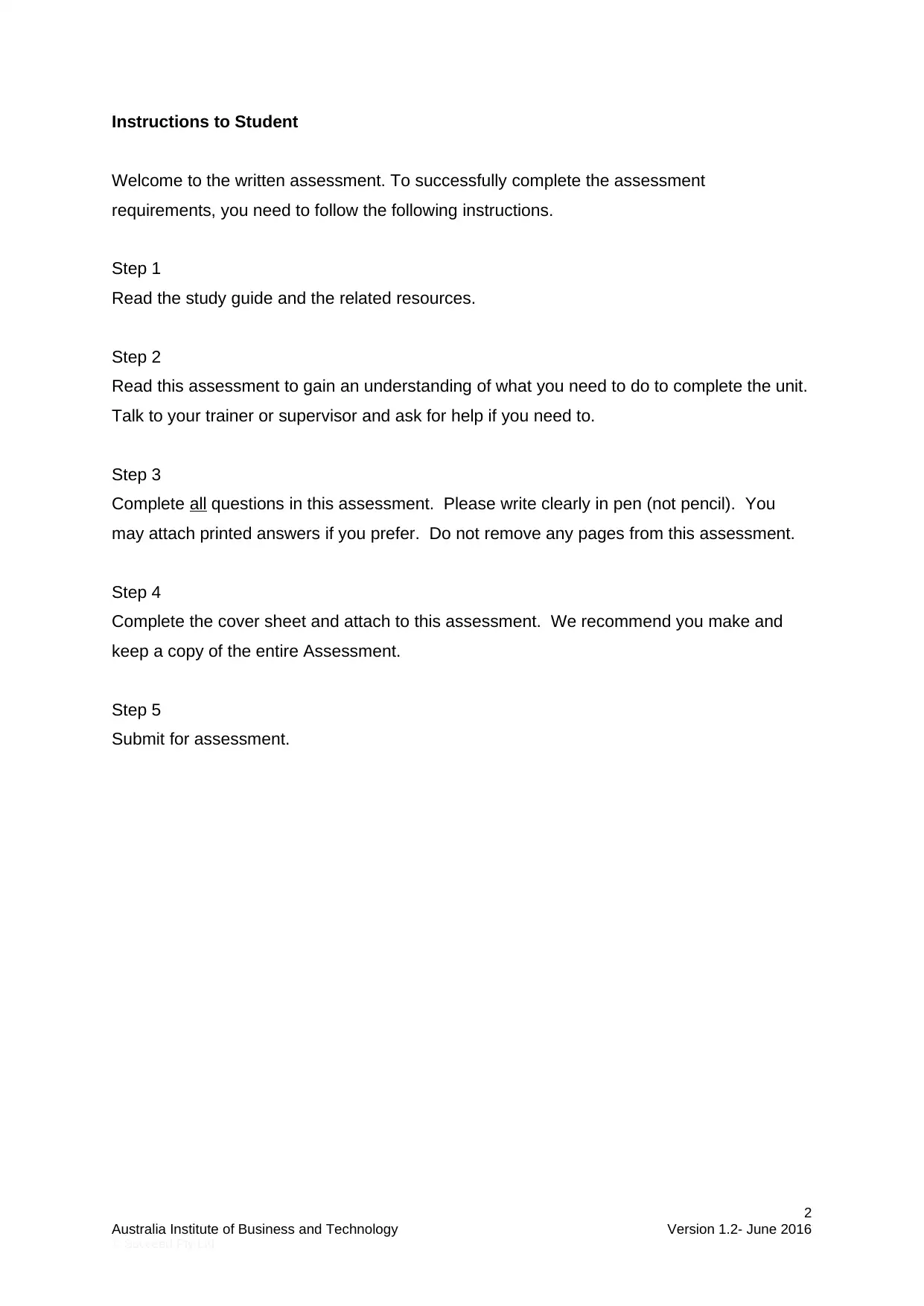
Instructions to Student
Welcome to the written assessment. To successfully complete the assessment
requirements, you need to follow the following instructions.
Step 1
Read the study guide and the related resources.
Step 2
Read this assessment to gain an understanding of what you need to do to complete the unit.
Talk to your trainer or supervisor and ask for help if you need to.
Step 3
Complete all questions in this assessment. Please write clearly in pen (not pencil). You
may attach printed answers if you prefer. Do not remove any pages from this assessment.
Step 4
Complete the cover sheet and attach to this assessment. We recommend you make and
keep a copy of the entire Assessment.
Step 5
Submit for assessment.
2
Australia Institute of Business and Technology Version 1.2- June 2016
© Succeed Pty Ltd
Welcome to the written assessment. To successfully complete the assessment
requirements, you need to follow the following instructions.
Step 1
Read the study guide and the related resources.
Step 2
Read this assessment to gain an understanding of what you need to do to complete the unit.
Talk to your trainer or supervisor and ask for help if you need to.
Step 3
Complete all questions in this assessment. Please write clearly in pen (not pencil). You
may attach printed answers if you prefer. Do not remove any pages from this assessment.
Step 4
Complete the cover sheet and attach to this assessment. We recommend you make and
keep a copy of the entire Assessment.
Step 5
Submit for assessment.
2
Australia Institute of Business and Technology Version 1.2- June 2016
© Succeed Pty Ltd

Question 1
The following website may assist with this question
https://www.asthmaaustralia.org.au/national/about-asthma/what-is-asthma
Asthma is a common medical condition in which the airways swell, produce copious
amounts of mucus, and become narrow. These events can trigger wheezing,
coughing and make it difficult for a person to breathe.
Although some people only experience mild symptoms of asthma, others may have
significant problems with their breathing, which may interfere with their daily activities.
A few patients also experience life-threatening asthmatic attacks, which need
immediate medical attention.
There is no cure for asthma, but your symptoms can be treated. For nurses, making a
nursing diagnosis for asthma can help them recognise a patient's needs and plan for
their care.
Part A
List 3 pathophysiological changes that occur during an asthma attack?
Bronchoconstriction- constriction of the airways that makes breathing difficult and
occurs due to the contraction of the bronchial smooth muscles.
Airway oedema and airway responsiveness- Inflammation of the airways causes
edema
Airway hyper-responsiveness and excessive secretion of mucus- This occurs due to
inflammation, structural changes in the airways. Airway remodelling involves the
activation of certain structural cells, with permanent change in the airways that
increases the airflow obstruction.
Part B
Ineffective airway clearance related to asthma results from the body's overproduction of
antibodies and release of chemicals, which trigger tightening of the airways (bronchospasm),
a major characteristic of asthma. This is often coupled with mucus build-up, which plugs the
airways, causing ineffective clearance of the airways. What are the signs of ineffective
airway clearance?
3
Australia Institute of Business and Technology Version 1.2- June 2016
© Succeed Pty Ltd
The following website may assist with this question
https://www.asthmaaustralia.org.au/national/about-asthma/what-is-asthma
Asthma is a common medical condition in which the airways swell, produce copious
amounts of mucus, and become narrow. These events can trigger wheezing,
coughing and make it difficult for a person to breathe.
Although some people only experience mild symptoms of asthma, others may have
significant problems with their breathing, which may interfere with their daily activities.
A few patients also experience life-threatening asthmatic attacks, which need
immediate medical attention.
There is no cure for asthma, but your symptoms can be treated. For nurses, making a
nursing diagnosis for asthma can help them recognise a patient's needs and plan for
their care.
Part A
List 3 pathophysiological changes that occur during an asthma attack?
Bronchoconstriction- constriction of the airways that makes breathing difficult and
occurs due to the contraction of the bronchial smooth muscles.
Airway oedema and airway responsiveness- Inflammation of the airways causes
edema
Airway hyper-responsiveness and excessive secretion of mucus- This occurs due to
inflammation, structural changes in the airways. Airway remodelling involves the
activation of certain structural cells, with permanent change in the airways that
increases the airflow obstruction.
Part B
Ineffective airway clearance related to asthma results from the body's overproduction of
antibodies and release of chemicals, which trigger tightening of the airways (bronchospasm),
a major characteristic of asthma. This is often coupled with mucus build-up, which plugs the
airways, causing ineffective clearance of the airways. What are the signs of ineffective
airway clearance?
3
Australia Institute of Business and Technology Version 1.2- June 2016
© Succeed Pty Ltd
⊘ This is a preview!⊘
Do you want full access?
Subscribe today to unlock all pages.

Trusted by 1+ million students worldwide

Ineffective clearance is characterised by abnormal breathing sounds known as wheezing,
abnormal respiratory rate, dyspnoea, excessive secretions, cyanosis, inability to remove the
secretions in the airways, orthopnoea.
Part C
What are your nursing Interventions for a client with Ineffective airway clearance?
Assessing the patients for abnormal breathing sounds, rates and depths of
respirations like apnoea, apneues, Kussmaul’s respiration.
Patient should be assessed for any changes in the heart rate, blood pressure and the
temperature, cough and productivity, colour, odour and the consistency of sputum.
The patient should be educated about the proper ways of breathing or coughing,
using the abdominal muscles for more forceful cough.
Perform nasotracheal suctioning if coughing is ineffective.
The patient should be encouraged to take enough fluids.
Patient should be educated about the use of humidifiers.
Part D
Ineffective breathing pattern is the nursing diagnosis for asthma is due to the presence of
mucus in the airways (bronchi), which results in blockage of air to the lungs and the body.
Inability to keep the airways clear due to bronchospasm is caused by stimulation of the
receptors and chemical mediators, which are released in the presence of irritants or
allergens. What are the symptoms?
Apnea
Altered chest excursion
Changes in the respiratory rate and depth
Cyanosis
Cough
Pattern- Bending in the forward direction while supporting himself by placing one
hand on each of the knees.
Part E
What are your nursing interventions for a client with ineffective breathing pattern?
4
Australia Institute of Business and Technology Version 1.2- June 2016
© Succeed Pty Ltd
abnormal respiratory rate, dyspnoea, excessive secretions, cyanosis, inability to remove the
secretions in the airways, orthopnoea.
Part C
What are your nursing Interventions for a client with Ineffective airway clearance?
Assessing the patients for abnormal breathing sounds, rates and depths of
respirations like apnoea, apneues, Kussmaul’s respiration.
Patient should be assessed for any changes in the heart rate, blood pressure and the
temperature, cough and productivity, colour, odour and the consistency of sputum.
The patient should be educated about the proper ways of breathing or coughing,
using the abdominal muscles for more forceful cough.
Perform nasotracheal suctioning if coughing is ineffective.
The patient should be encouraged to take enough fluids.
Patient should be educated about the use of humidifiers.
Part D
Ineffective breathing pattern is the nursing diagnosis for asthma is due to the presence of
mucus in the airways (bronchi), which results in blockage of air to the lungs and the body.
Inability to keep the airways clear due to bronchospasm is caused by stimulation of the
receptors and chemical mediators, which are released in the presence of irritants or
allergens. What are the symptoms?
Apnea
Altered chest excursion
Changes in the respiratory rate and depth
Cyanosis
Cough
Pattern- Bending in the forward direction while supporting himself by placing one
hand on each of the knees.
Part E
What are your nursing interventions for a client with ineffective breathing pattern?
4
Australia Institute of Business and Technology Version 1.2- June 2016
© Succeed Pty Ltd
Paraphrase This Document
Need a fresh take? Get an instant paraphrase of this document with our AI Paraphraser
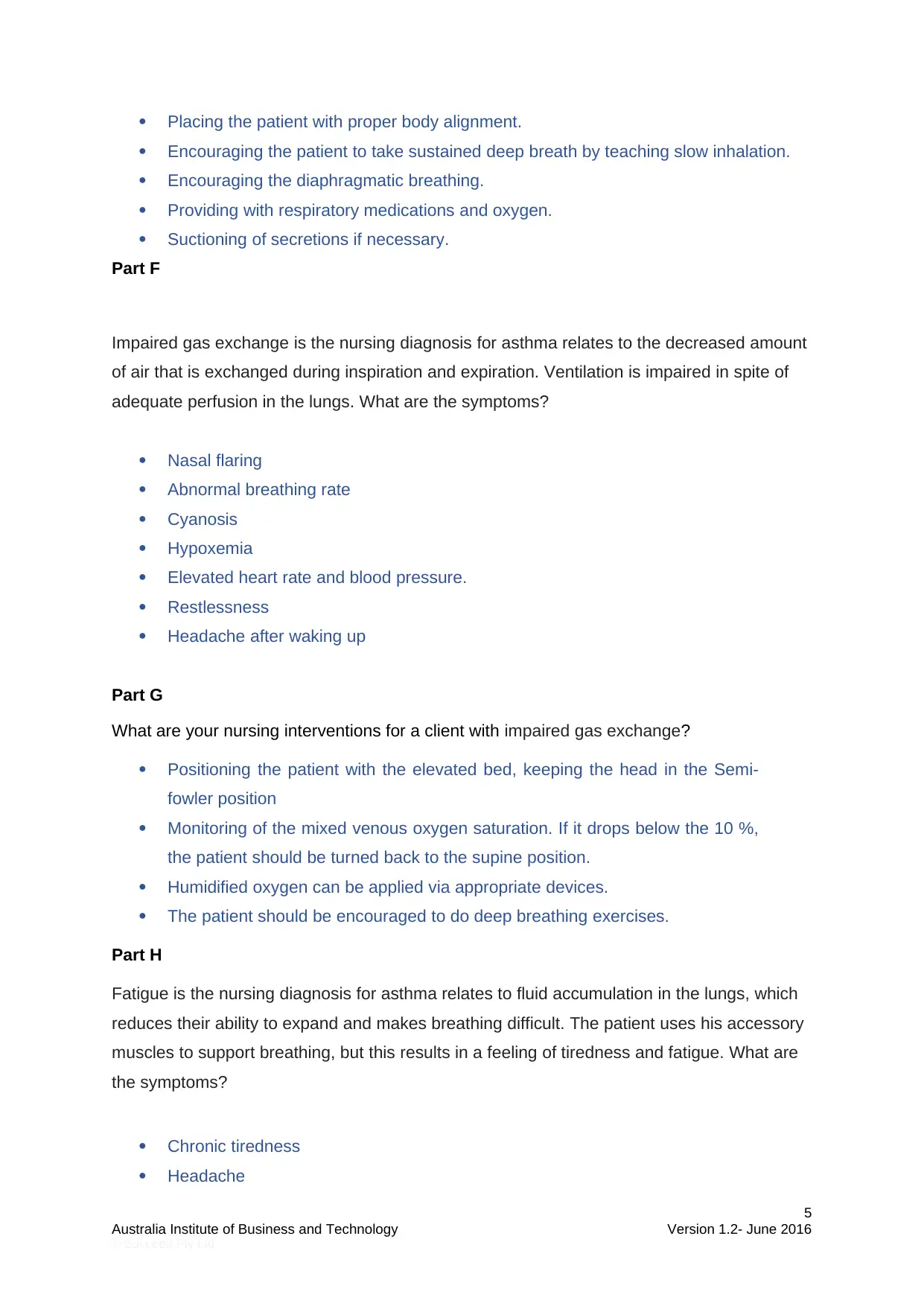
Placing the patient with proper body alignment.
Encouraging the patient to take sustained deep breath by teaching slow inhalation.
Encouraging the diaphragmatic breathing.
Providing with respiratory medications and oxygen.
Suctioning of secretions if necessary.
Part F
Impaired gas exchange is the nursing diagnosis for asthma relates to the decreased amount
of air that is exchanged during inspiration and expiration. Ventilation is impaired in spite of
adequate perfusion in the lungs. What are the symptoms?
Nasal flaring
Abnormal breathing rate
Cyanosis
Hypoxemia
Elevated heart rate and blood pressure.
Restlessness
Headache after waking up
Part G
What are your nursing interventions for a client with impaired gas exchange?
Positioning the patient with the elevated bed, keeping the head in the Semi-
fowler position
Monitoring of the mixed venous oxygen saturation. If it drops below the 10 %,
the patient should be turned back to the supine position.
Humidified oxygen can be applied via appropriate devices.
The patient should be encouraged to do deep breathing exercises.
Part H
Fatigue is the nursing diagnosis for asthma relates to fluid accumulation in the lungs, which
reduces their ability to expand and makes breathing difficult. The patient uses his accessory
muscles to support breathing, but this results in a feeling of tiredness and fatigue. What are
the symptoms?
Chronic tiredness
Headache
5
Australia Institute of Business and Technology Version 1.2- June 2016
© Succeed Pty Ltd
Encouraging the patient to take sustained deep breath by teaching slow inhalation.
Encouraging the diaphragmatic breathing.
Providing with respiratory medications and oxygen.
Suctioning of secretions if necessary.
Part F
Impaired gas exchange is the nursing diagnosis for asthma relates to the decreased amount
of air that is exchanged during inspiration and expiration. Ventilation is impaired in spite of
adequate perfusion in the lungs. What are the symptoms?
Nasal flaring
Abnormal breathing rate
Cyanosis
Hypoxemia
Elevated heart rate and blood pressure.
Restlessness
Headache after waking up
Part G
What are your nursing interventions for a client with impaired gas exchange?
Positioning the patient with the elevated bed, keeping the head in the Semi-
fowler position
Monitoring of the mixed venous oxygen saturation. If it drops below the 10 %,
the patient should be turned back to the supine position.
Humidified oxygen can be applied via appropriate devices.
The patient should be encouraged to do deep breathing exercises.
Part H
Fatigue is the nursing diagnosis for asthma relates to fluid accumulation in the lungs, which
reduces their ability to expand and makes breathing difficult. The patient uses his accessory
muscles to support breathing, but this results in a feeling of tiredness and fatigue. What are
the symptoms?
Chronic tiredness
Headache
5
Australia Institute of Business and Technology Version 1.2- June 2016
© Succeed Pty Ltd
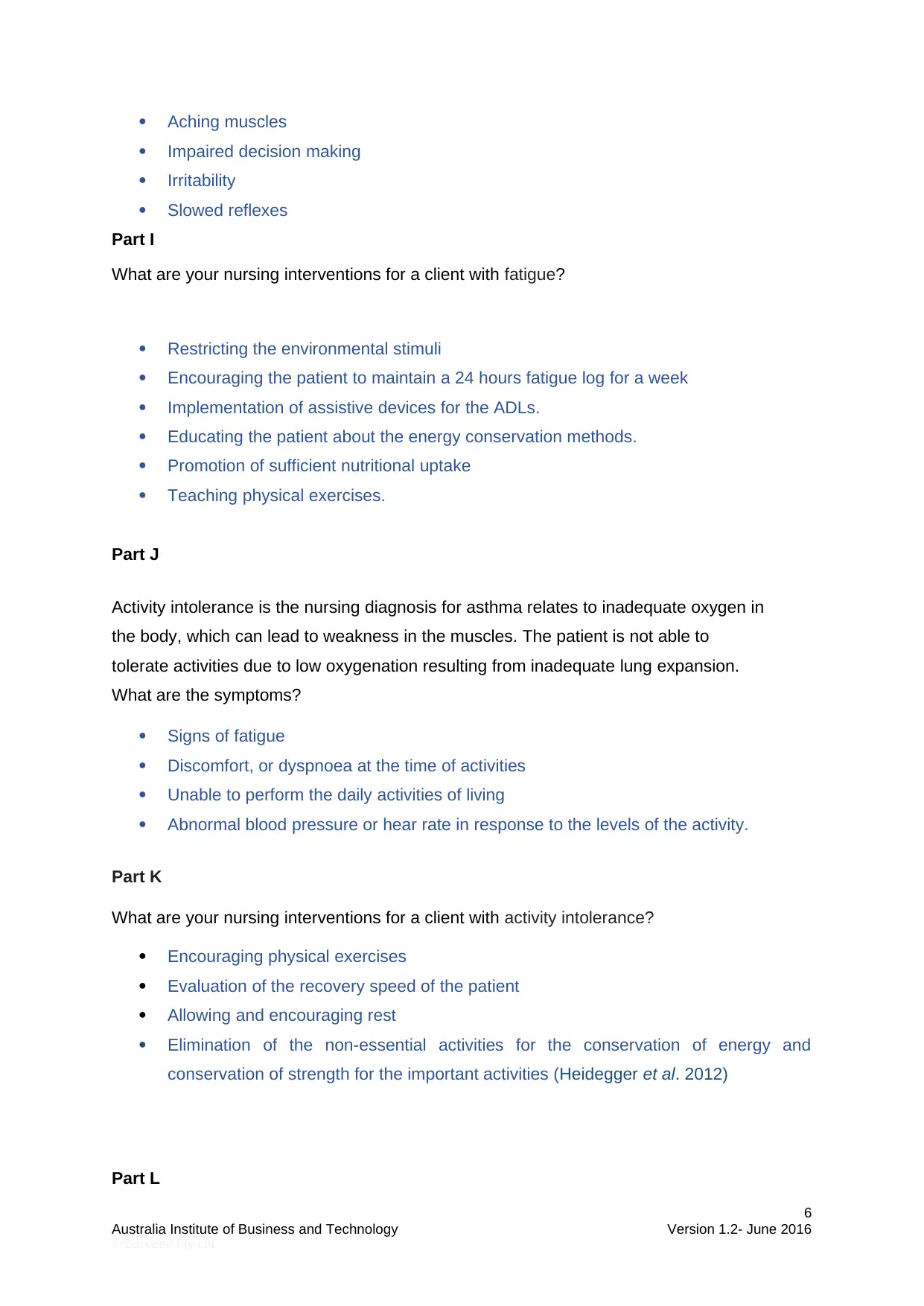
Aching muscles
Impaired decision making
Irritability
Slowed reflexes
Part I
What are your nursing interventions for a client with fatigue?
Restricting the environmental stimuli
Encouraging the patient to maintain a 24 hours fatigue log for a week
Implementation of assistive devices for the ADLs.
Educating the patient about the energy conservation methods.
Promotion of sufficient nutritional uptake
Teaching physical exercises.
Part J
Activity intolerance is the nursing diagnosis for asthma relates to inadequate oxygen in
the body, which can lead to weakness in the muscles. The patient is not able to
tolerate activities due to low oxygenation resulting from inadequate lung expansion.
What are the symptoms?
Signs of fatigue
Discomfort, or dyspnoea at the time of activities
Unable to perform the daily activities of living
Abnormal blood pressure or hear rate in response to the levels of the activity.
Part K
What are your nursing interventions for a client with activity intolerance?
Encouraging physical exercises
Evaluation of the recovery speed of the patient
Allowing and encouraging rest
Elimination of the non-essential activities for the conservation of energy and
conservation of strength for the important activities (Heidegger et al. 2012)
Part L
6
Australia Institute of Business and Technology Version 1.2- June 2016
© Succeed Pty Ltd
Impaired decision making
Irritability
Slowed reflexes
Part I
What are your nursing interventions for a client with fatigue?
Restricting the environmental stimuli
Encouraging the patient to maintain a 24 hours fatigue log for a week
Implementation of assistive devices for the ADLs.
Educating the patient about the energy conservation methods.
Promotion of sufficient nutritional uptake
Teaching physical exercises.
Part J
Activity intolerance is the nursing diagnosis for asthma relates to inadequate oxygen in
the body, which can lead to weakness in the muscles. The patient is not able to
tolerate activities due to low oxygenation resulting from inadequate lung expansion.
What are the symptoms?
Signs of fatigue
Discomfort, or dyspnoea at the time of activities
Unable to perform the daily activities of living
Abnormal blood pressure or hear rate in response to the levels of the activity.
Part K
What are your nursing interventions for a client with activity intolerance?
Encouraging physical exercises
Evaluation of the recovery speed of the patient
Allowing and encouraging rest
Elimination of the non-essential activities for the conservation of energy and
conservation of strength for the important activities (Heidegger et al. 2012)
Part L
6
Australia Institute of Business and Technology Version 1.2- June 2016
© Succeed Pty Ltd
⊘ This is a preview!⊘
Do you want full access?
Subscribe today to unlock all pages.

Trusted by 1+ million students worldwide
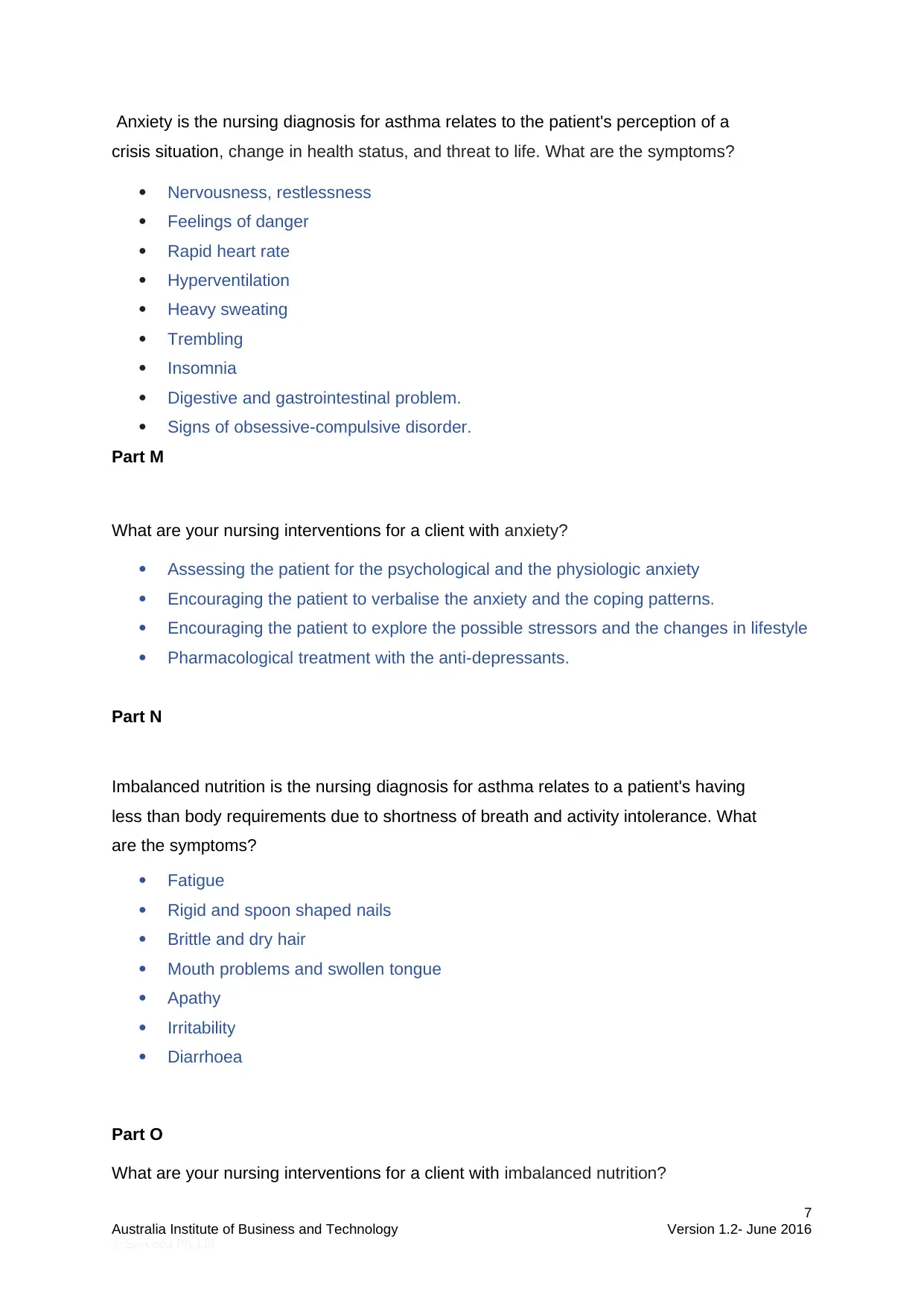
Anxiety is the nursing diagnosis for asthma relates to the patient's perception of a
crisis situation, change in health status, and threat to life. What are the symptoms?
Nervousness, restlessness
Feelings of danger
Rapid heart rate
Hyperventilation
Heavy sweating
Trembling
Insomnia
Digestive and gastrointestinal problem.
Signs of obsessive-compulsive disorder.
Part M
What are your nursing interventions for a client with anxiety?
Assessing the patient for the psychological and the physiologic anxiety
Encouraging the patient to verbalise the anxiety and the coping patterns.
Encouraging the patient to explore the possible stressors and the changes in lifestyle
Pharmacological treatment with the anti-depressants.
Part N
Imbalanced nutrition is the nursing diagnosis for asthma relates to a patient's having
less than body requirements due to shortness of breath and activity intolerance. What
are the symptoms?
Fatigue
Rigid and spoon shaped nails
Brittle and dry hair
Mouth problems and swollen tongue
Apathy
Irritability
Diarrhoea
Part O
What are your nursing interventions for a client with imbalanced nutrition?
7
Australia Institute of Business and Technology Version 1.2- June 2016
© Succeed Pty Ltd
crisis situation, change in health status, and threat to life. What are the symptoms?
Nervousness, restlessness
Feelings of danger
Rapid heart rate
Hyperventilation
Heavy sweating
Trembling
Insomnia
Digestive and gastrointestinal problem.
Signs of obsessive-compulsive disorder.
Part M
What are your nursing interventions for a client with anxiety?
Assessing the patient for the psychological and the physiologic anxiety
Encouraging the patient to verbalise the anxiety and the coping patterns.
Encouraging the patient to explore the possible stressors and the changes in lifestyle
Pharmacological treatment with the anti-depressants.
Part N
Imbalanced nutrition is the nursing diagnosis for asthma relates to a patient's having
less than body requirements due to shortness of breath and activity intolerance. What
are the symptoms?
Fatigue
Rigid and spoon shaped nails
Brittle and dry hair
Mouth problems and swollen tongue
Apathy
Irritability
Diarrhoea
Part O
What are your nursing interventions for a client with imbalanced nutrition?
7
Australia Institute of Business and Technology Version 1.2- June 2016
© Succeed Pty Ltd
Paraphrase This Document
Need a fresh take? Get an instant paraphrase of this document with our AI Paraphraser
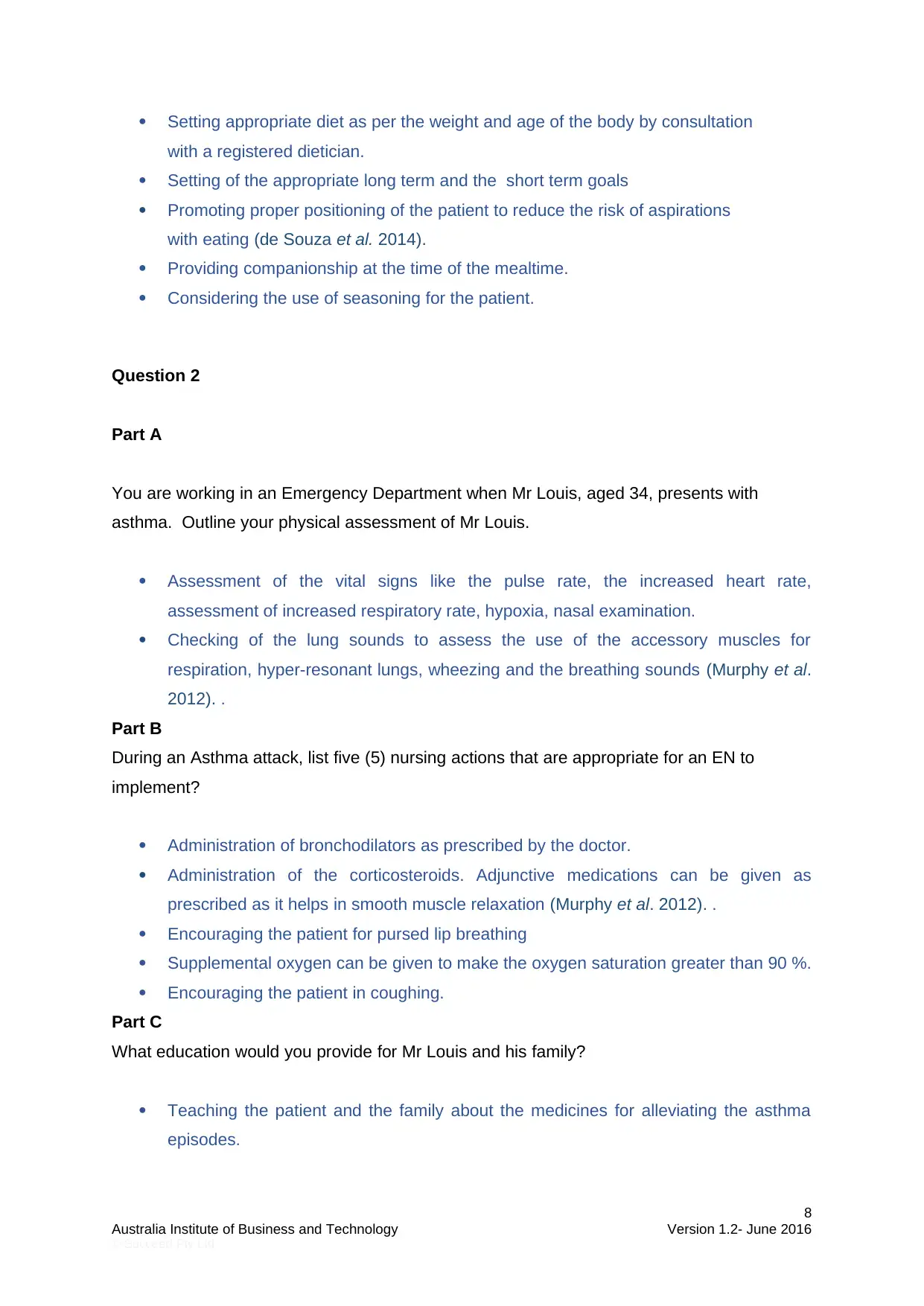
Setting appropriate diet as per the weight and age of the body by consultation
with a registered dietician.
Setting of the appropriate long term and the short term goals
Promoting proper positioning of the patient to reduce the risk of aspirations
with eating (de Souza et al. 2014).
Providing companionship at the time of the mealtime.
Considering the use of seasoning for the patient.
Question 2
Part A
You are working in an Emergency Department when Mr Louis, aged 34, presents with
asthma. Outline your physical assessment of Mr Louis.
Assessment of the vital signs like the pulse rate, the increased heart rate,
assessment of increased respiratory rate, hypoxia, nasal examination.
Checking of the lung sounds to assess the use of the accessory muscles for
respiration, hyper-resonant lungs, wheezing and the breathing sounds (Murphy et al.
2012). .
Part B
During an Asthma attack, list five (5) nursing actions that are appropriate for an EN to
implement?
Administration of bronchodilators as prescribed by the doctor.
Administration of the corticosteroids. Adjunctive medications can be given as
prescribed as it helps in smooth muscle relaxation (Murphy et al. 2012). .
Encouraging the patient for pursed lip breathing
Supplemental oxygen can be given to make the oxygen saturation greater than 90 %.
Encouraging the patient in coughing.
Part C
What education would you provide for Mr Louis and his family?
Teaching the patient and the family about the medicines for alleviating the asthma
episodes.
8
Australia Institute of Business and Technology Version 1.2- June 2016
© Succeed Pty Ltd
with a registered dietician.
Setting of the appropriate long term and the short term goals
Promoting proper positioning of the patient to reduce the risk of aspirations
with eating (de Souza et al. 2014).
Providing companionship at the time of the mealtime.
Considering the use of seasoning for the patient.
Question 2
Part A
You are working in an Emergency Department when Mr Louis, aged 34, presents with
asthma. Outline your physical assessment of Mr Louis.
Assessment of the vital signs like the pulse rate, the increased heart rate,
assessment of increased respiratory rate, hypoxia, nasal examination.
Checking of the lung sounds to assess the use of the accessory muscles for
respiration, hyper-resonant lungs, wheezing and the breathing sounds (Murphy et al.
2012). .
Part B
During an Asthma attack, list five (5) nursing actions that are appropriate for an EN to
implement?
Administration of bronchodilators as prescribed by the doctor.
Administration of the corticosteroids. Adjunctive medications can be given as
prescribed as it helps in smooth muscle relaxation (Murphy et al. 2012). .
Encouraging the patient for pursed lip breathing
Supplemental oxygen can be given to make the oxygen saturation greater than 90 %.
Encouraging the patient in coughing.
Part C
What education would you provide for Mr Louis and his family?
Teaching the patient and the family about the medicines for alleviating the asthma
episodes.
8
Australia Institute of Business and Technology Version 1.2- June 2016
© Succeed Pty Ltd
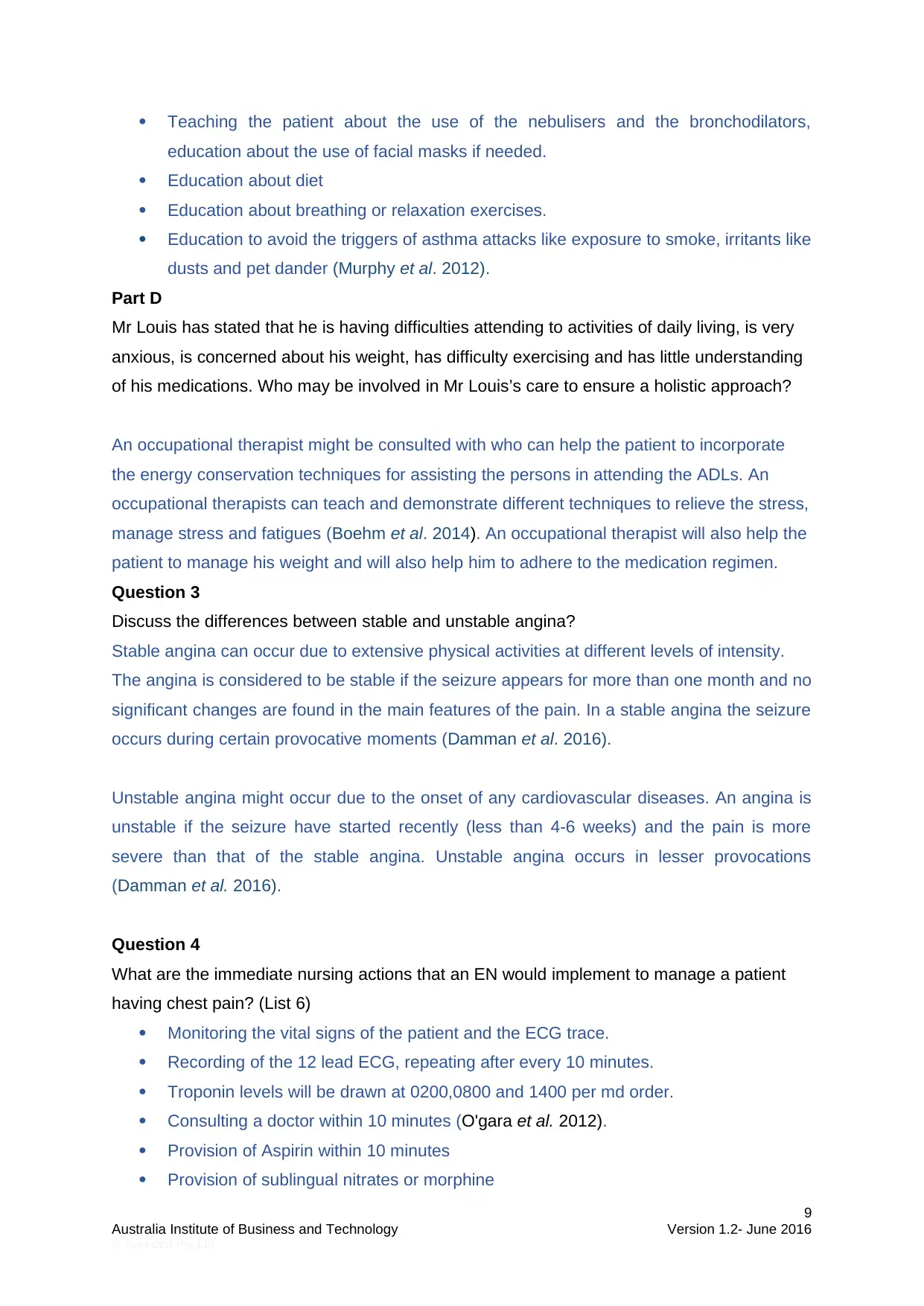
Teaching the patient about the use of the nebulisers and the bronchodilators,
education about the use of facial masks if needed.
Education about diet
Education about breathing or relaxation exercises.
Education to avoid the triggers of asthma attacks like exposure to smoke, irritants like
dusts and pet dander (Murphy et al. 2012).
Part D
Mr Louis has stated that he is having difficulties attending to activities of daily living, is very
anxious, is concerned about his weight, has difficulty exercising and has little understanding
of his medications. Who may be involved in Mr Louis’s care to ensure a holistic approach?
An occupational therapist might be consulted with who can help the patient to incorporate
the energy conservation techniques for assisting the persons in attending the ADLs. An
occupational therapists can teach and demonstrate different techniques to relieve the stress,
manage stress and fatigues (Boehm et al. 2014). An occupational therapist will also help the
patient to manage his weight and will also help him to adhere to the medication regimen.
Question 3
Discuss the differences between stable and unstable angina?
Stable angina can occur due to extensive physical activities at different levels of intensity.
The angina is considered to be stable if the seizure appears for more than one month and no
significant changes are found in the main features of the pain. In a stable angina the seizure
occurs during certain provocative moments (Damman et al. 2016).
Unstable angina might occur due to the onset of any cardiovascular diseases. An angina is
unstable if the seizure have started recently (less than 4-6 weeks) and the pain is more
severe than that of the stable angina. Unstable angina occurs in lesser provocations
(Damman et al. 2016).
Question 4
What are the immediate nursing actions that an EN would implement to manage a patient
having chest pain? (List 6)
Monitoring the vital signs of the patient and the ECG trace.
Recording of the 12 lead ECG, repeating after every 10 minutes.
Troponin levels will be drawn at 0200,0800 and 1400 per md order.
Consulting a doctor within 10 minutes (O'gara et al. 2012).
Provision of Aspirin within 10 minutes
Provision of sublingual nitrates or morphine
9
Australia Institute of Business and Technology Version 1.2- June 2016
© Succeed Pty Ltd
education about the use of facial masks if needed.
Education about diet
Education about breathing or relaxation exercises.
Education to avoid the triggers of asthma attacks like exposure to smoke, irritants like
dusts and pet dander (Murphy et al. 2012).
Part D
Mr Louis has stated that he is having difficulties attending to activities of daily living, is very
anxious, is concerned about his weight, has difficulty exercising and has little understanding
of his medications. Who may be involved in Mr Louis’s care to ensure a holistic approach?
An occupational therapist might be consulted with who can help the patient to incorporate
the energy conservation techniques for assisting the persons in attending the ADLs. An
occupational therapists can teach and demonstrate different techniques to relieve the stress,
manage stress and fatigues (Boehm et al. 2014). An occupational therapist will also help the
patient to manage his weight and will also help him to adhere to the medication regimen.
Question 3
Discuss the differences between stable and unstable angina?
Stable angina can occur due to extensive physical activities at different levels of intensity.
The angina is considered to be stable if the seizure appears for more than one month and no
significant changes are found in the main features of the pain. In a stable angina the seizure
occurs during certain provocative moments (Damman et al. 2016).
Unstable angina might occur due to the onset of any cardiovascular diseases. An angina is
unstable if the seizure have started recently (less than 4-6 weeks) and the pain is more
severe than that of the stable angina. Unstable angina occurs in lesser provocations
(Damman et al. 2016).
Question 4
What are the immediate nursing actions that an EN would implement to manage a patient
having chest pain? (List 6)
Monitoring the vital signs of the patient and the ECG trace.
Recording of the 12 lead ECG, repeating after every 10 minutes.
Troponin levels will be drawn at 0200,0800 and 1400 per md order.
Consulting a doctor within 10 minutes (O'gara et al. 2012).
Provision of Aspirin within 10 minutes
Provision of sublingual nitrates or morphine
9
Australia Institute of Business and Technology Version 1.2- June 2016
© Succeed Pty Ltd
⊘ This is a preview!⊘
Do you want full access?
Subscribe today to unlock all pages.

Trusted by 1+ million students worldwide
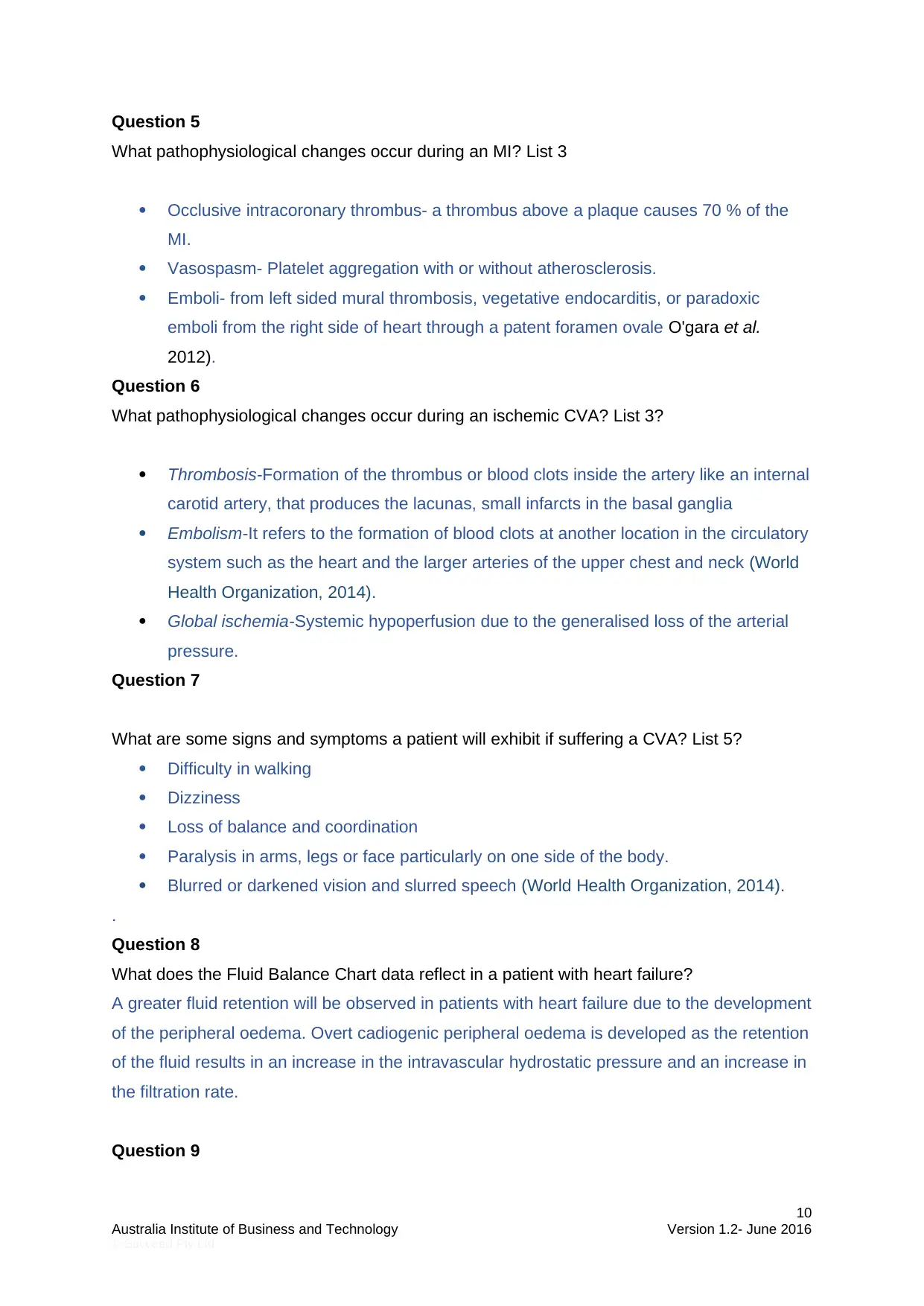
Question 5
What pathophysiological changes occur during an MI? List 3
Occlusive intracoronary thrombus- a thrombus above a plaque causes 70 % of the
MI.
Vasospasm- Platelet aggregation with or without atherosclerosis.
Emboli- from left sided mural thrombosis, vegetative endocarditis, or paradoxic
emboli from the right side of heart through a patent foramen ovale O'gara et al.
2012).
Question 6
What pathophysiological changes occur during an ischemic CVA? List 3?
Thrombosis-Formation of the thrombus or blood clots inside the artery like an internal
carotid artery, that produces the lacunas, small infarcts in the basal ganglia
Embolism-It refers to the formation of blood clots at another location in the circulatory
system such as the heart and the larger arteries of the upper chest and neck (World
Health Organization, 2014).
Global ischemia-Systemic hypoperfusion due to the generalised loss of the arterial
pressure.
Question 7
What are some signs and symptoms a patient will exhibit if suffering a CVA? List 5?
Difficulty in walking
Dizziness
Loss of balance and coordination
Paralysis in arms, legs or face particularly on one side of the body.
Blurred or darkened vision and slurred speech (World Health Organization, 2014).
.
Question 8
What does the Fluid Balance Chart data reflect in a patient with heart failure?
A greater fluid retention will be observed in patients with heart failure due to the development
of the peripheral oedema. Overt cadiogenic peripheral oedema is developed as the retention
of the fluid results in an increase in the intravascular hydrostatic pressure and an increase in
the filtration rate.
Question 9
10
Australia Institute of Business and Technology Version 1.2- June 2016
© Succeed Pty Ltd
What pathophysiological changes occur during an MI? List 3
Occlusive intracoronary thrombus- a thrombus above a plaque causes 70 % of the
MI.
Vasospasm- Platelet aggregation with or without atherosclerosis.
Emboli- from left sided mural thrombosis, vegetative endocarditis, or paradoxic
emboli from the right side of heart through a patent foramen ovale O'gara et al.
2012).
Question 6
What pathophysiological changes occur during an ischemic CVA? List 3?
Thrombosis-Formation of the thrombus or blood clots inside the artery like an internal
carotid artery, that produces the lacunas, small infarcts in the basal ganglia
Embolism-It refers to the formation of blood clots at another location in the circulatory
system such as the heart and the larger arteries of the upper chest and neck (World
Health Organization, 2014).
Global ischemia-Systemic hypoperfusion due to the generalised loss of the arterial
pressure.
Question 7
What are some signs and symptoms a patient will exhibit if suffering a CVA? List 5?
Difficulty in walking
Dizziness
Loss of balance and coordination
Paralysis in arms, legs or face particularly on one side of the body.
Blurred or darkened vision and slurred speech (World Health Organization, 2014).
.
Question 8
What does the Fluid Balance Chart data reflect in a patient with heart failure?
A greater fluid retention will be observed in patients with heart failure due to the development
of the peripheral oedema. Overt cadiogenic peripheral oedema is developed as the retention
of the fluid results in an increase in the intravascular hydrostatic pressure and an increase in
the filtration rate.
Question 9
10
Australia Institute of Business and Technology Version 1.2- June 2016
© Succeed Pty Ltd
Paraphrase This Document
Need a fresh take? Get an instant paraphrase of this document with our AI Paraphraser
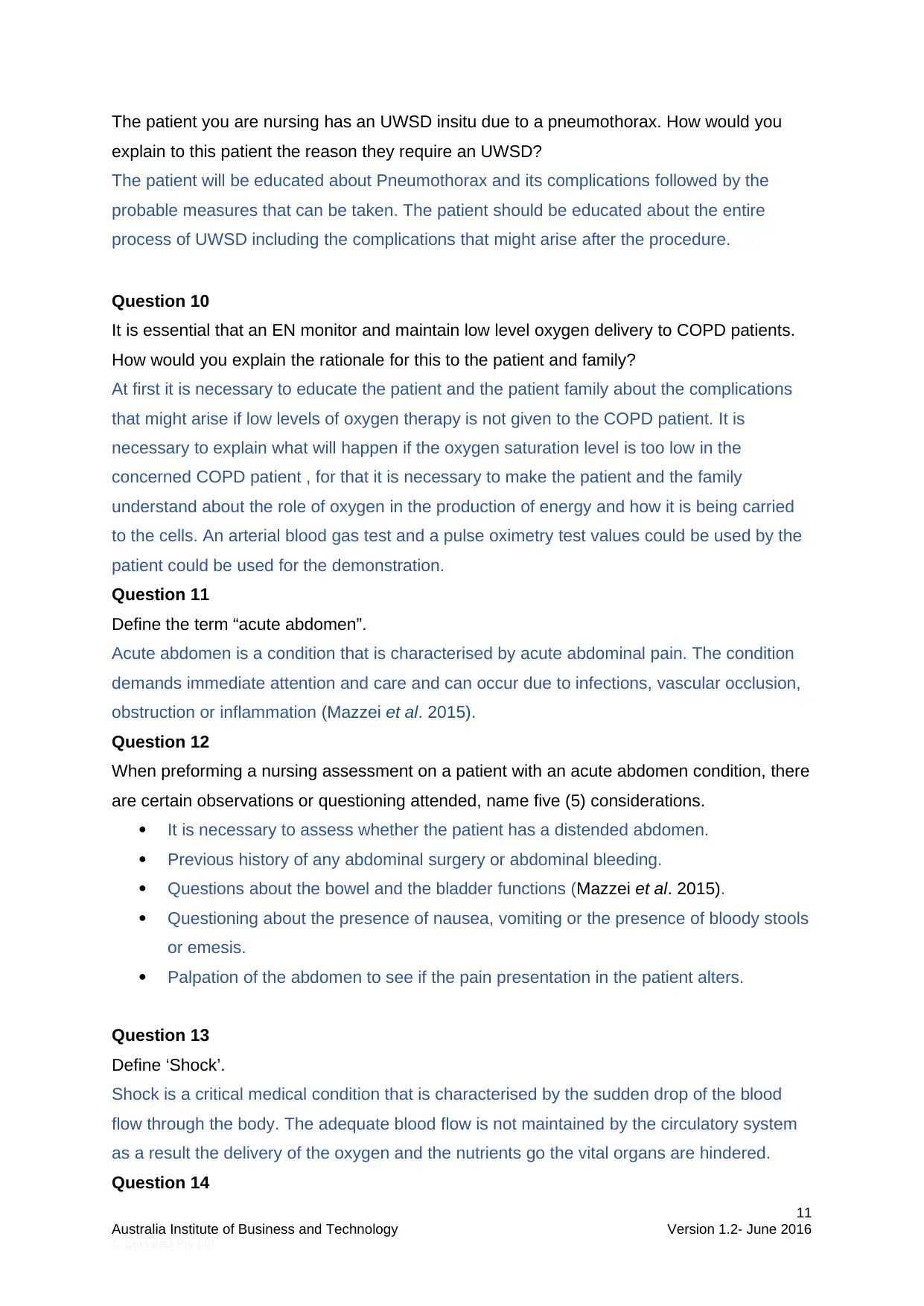
The patient you are nursing has an UWSD insitu due to a pneumothorax. How would you
explain to this patient the reason they require an UWSD?
The patient will be educated about Pneumothorax and its complications followed by the
probable measures that can be taken. The patient should be educated about the entire
process of UWSD including the complications that might arise after the procedure.
Question 10
It is essential that an EN monitor and maintain low level oxygen delivery to COPD patients.
How would you explain the rationale for this to the patient and family?
At first it is necessary to educate the patient and the patient family about the complications
that might arise if low levels of oxygen therapy is not given to the COPD patient. It is
necessary to explain what will happen if the oxygen saturation level is too low in the
concerned COPD patient , for that it is necessary to make the patient and the family
understand about the role of oxygen in the production of energy and how it is being carried
to the cells. An arterial blood gas test and a pulse oximetry test values could be used by the
patient could be used for the demonstration.
Question 11
Define the term “acute abdomen”.
Acute abdomen is a condition that is characterised by acute abdominal pain. The condition
demands immediate attention and care and can occur due to infections, vascular occlusion,
obstruction or inflammation (Mazzei et al. 2015).
Question 12
When preforming a nursing assessment on a patient with an acute abdomen condition, there
are certain observations or questioning attended, name five (5) considerations.
It is necessary to assess whether the patient has a distended abdomen.
Previous history of any abdominal surgery or abdominal bleeding.
Questions about the bowel and the bladder functions (Mazzei et al. 2015).
Questioning about the presence of nausea, vomiting or the presence of bloody stools
or emesis.
Palpation of the abdomen to see if the pain presentation in the patient alters.
Question 13
Define ‘Shock’.
Shock is a critical medical condition that is characterised by the sudden drop of the blood
flow through the body. The adequate blood flow is not maintained by the circulatory system
as a result the delivery of the oxygen and the nutrients go the vital organs are hindered.
Question 14
11
Australia Institute of Business and Technology Version 1.2- June 2016
© Succeed Pty Ltd
explain to this patient the reason they require an UWSD?
The patient will be educated about Pneumothorax and its complications followed by the
probable measures that can be taken. The patient should be educated about the entire
process of UWSD including the complications that might arise after the procedure.
Question 10
It is essential that an EN monitor and maintain low level oxygen delivery to COPD patients.
How would you explain the rationale for this to the patient and family?
At first it is necessary to educate the patient and the patient family about the complications
that might arise if low levels of oxygen therapy is not given to the COPD patient. It is
necessary to explain what will happen if the oxygen saturation level is too low in the
concerned COPD patient , for that it is necessary to make the patient and the family
understand about the role of oxygen in the production of energy and how it is being carried
to the cells. An arterial blood gas test and a pulse oximetry test values could be used by the
patient could be used for the demonstration.
Question 11
Define the term “acute abdomen”.
Acute abdomen is a condition that is characterised by acute abdominal pain. The condition
demands immediate attention and care and can occur due to infections, vascular occlusion,
obstruction or inflammation (Mazzei et al. 2015).
Question 12
When preforming a nursing assessment on a patient with an acute abdomen condition, there
are certain observations or questioning attended, name five (5) considerations.
It is necessary to assess whether the patient has a distended abdomen.
Previous history of any abdominal surgery or abdominal bleeding.
Questions about the bowel and the bladder functions (Mazzei et al. 2015).
Questioning about the presence of nausea, vomiting or the presence of bloody stools
or emesis.
Palpation of the abdomen to see if the pain presentation in the patient alters.
Question 13
Define ‘Shock’.
Shock is a critical medical condition that is characterised by the sudden drop of the blood
flow through the body. The adequate blood flow is not maintained by the circulatory system
as a result the delivery of the oxygen and the nutrients go the vital organs are hindered.
Question 14
11
Australia Institute of Business and Technology Version 1.2- June 2016
© Succeed Pty Ltd
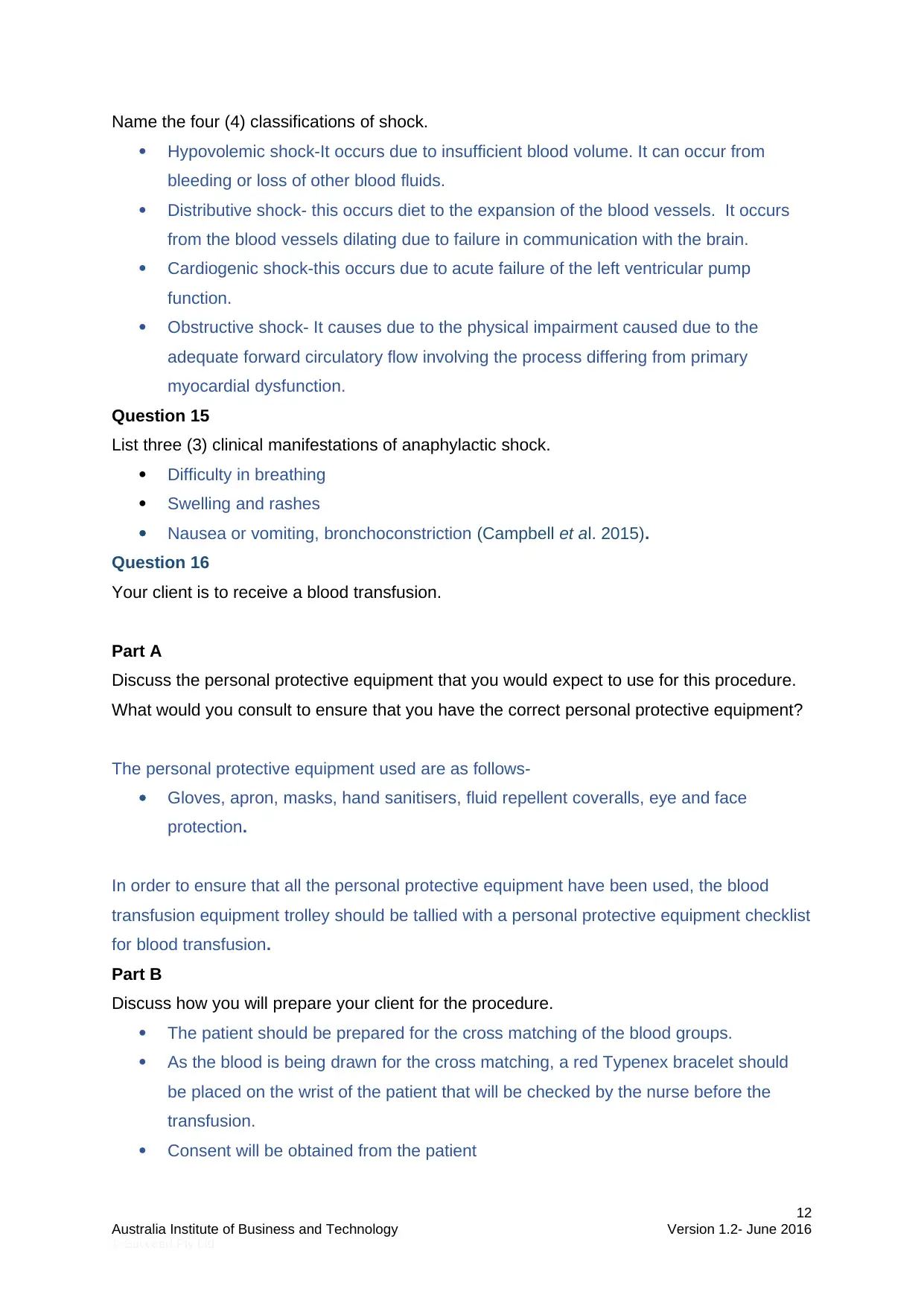
Name the four (4) classifications of shock.
Hypovolemic shock-It occurs due to insufficient blood volume. It can occur from
bleeding or loss of other blood fluids.
Distributive shock- this occurs diet to the expansion of the blood vessels. It occurs
from the blood vessels dilating due to failure in communication with the brain.
Cardiogenic shock-this occurs due to acute failure of the left ventricular pump
function.
Obstructive shock- It causes due to the physical impairment caused due to the
adequate forward circulatory flow involving the process differing from primary
myocardial dysfunction.
Question 15
List three (3) clinical manifestations of anaphylactic shock.
Difficulty in breathing
Swelling and rashes
Nausea or vomiting, bronchoconstriction (Campbell et al. 2015).
Question 16
Your client is to receive a blood transfusion.
Part A
Discuss the personal protective equipment that you would expect to use for this procedure.
What would you consult to ensure that you have the correct personal protective equipment?
The personal protective equipment used are as follows-
Gloves, apron, masks, hand sanitisers, fluid repellent coveralls, eye and face
protection.
In order to ensure that all the personal protective equipment have been used, the blood
transfusion equipment trolley should be tallied with a personal protective equipment checklist
for blood transfusion.
Part B
Discuss how you will prepare your client for the procedure.
The patient should be prepared for the cross matching of the blood groups.
As the blood is being drawn for the cross matching, a red Typenex bracelet should
be placed on the wrist of the patient that will be checked by the nurse before the
transfusion.
Consent will be obtained from the patient
12
Australia Institute of Business and Technology Version 1.2- June 2016
© Succeed Pty Ltd
Hypovolemic shock-It occurs due to insufficient blood volume. It can occur from
bleeding or loss of other blood fluids.
Distributive shock- this occurs diet to the expansion of the blood vessels. It occurs
from the blood vessels dilating due to failure in communication with the brain.
Cardiogenic shock-this occurs due to acute failure of the left ventricular pump
function.
Obstructive shock- It causes due to the physical impairment caused due to the
adequate forward circulatory flow involving the process differing from primary
myocardial dysfunction.
Question 15
List three (3) clinical manifestations of anaphylactic shock.
Difficulty in breathing
Swelling and rashes
Nausea or vomiting, bronchoconstriction (Campbell et al. 2015).
Question 16
Your client is to receive a blood transfusion.
Part A
Discuss the personal protective equipment that you would expect to use for this procedure.
What would you consult to ensure that you have the correct personal protective equipment?
The personal protective equipment used are as follows-
Gloves, apron, masks, hand sanitisers, fluid repellent coveralls, eye and face
protection.
In order to ensure that all the personal protective equipment have been used, the blood
transfusion equipment trolley should be tallied with a personal protective equipment checklist
for blood transfusion.
Part B
Discuss how you will prepare your client for the procedure.
The patient should be prepared for the cross matching of the blood groups.
As the blood is being drawn for the cross matching, a red Typenex bracelet should
be placed on the wrist of the patient that will be checked by the nurse before the
transfusion.
Consent will be obtained from the patient
12
Australia Institute of Business and Technology Version 1.2- June 2016
© Succeed Pty Ltd
⊘ This is a preview!⊘
Do you want full access?
Subscribe today to unlock all pages.

Trusted by 1+ million students worldwide
1 out of 23
Related Documents
Your All-in-One AI-Powered Toolkit for Academic Success.
+13062052269
info@desklib.com
Available 24*7 on WhatsApp / Email
![[object Object]](/_next/static/media/star-bottom.7253800d.svg)
Unlock your academic potential
Copyright © 2020–2025 A2Z Services. All Rights Reserved. Developed and managed by ZUCOL.




